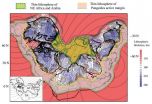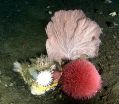HVTN 505 vaccine induced antibodies nonspecific for HIV
NIH-supported study explores why candidate HIV vaccine was not protective
2015-07-30
(Press-News.org) A study by researchers at the National Institute of Allergy and Infectious Diseases and Duke University helps explain why the candidate vaccine used in the HVTN 505 clinical trial was not protective against HIV infection despite robustly inducing anti-HIV antibodies: the vaccine stimulated antibodies that recognized HIV as well as microbes commonly found in the intestinal tract, part of the body's microbiome. The researchers suggest that these antibodies arose because the vaccine boosted an existing antibody response to the intestinal microbiome, which may explain why the HVTN 505 vaccine candidate did not perform well. Understanding why the candidate vaccine did not protect against HIV infection will inform ongoing vaccine research efforts against HIV and other infectious diseases.
The HVTN 505 study used an investigational vaccine regimen in which volunteers were vaccinated with an initial or "prime" vaccine followed by a second, booster vaccine. In the new study, researchers examined samples from study participants who received the prime-boost vaccine and found that most vaccine-induced antibodies recognized an HIV surface protein called gp41, but these antibodies did not neutralize HIV. Instead, the antibodies were polyreactive, recognizing other proteins common to bacteria, such as Escherichia coli, a naturally occurring part of the body's intestinal microbiome. Polyreactivity may decrease the effectiveness of antibodies against a specific pathogen like HIV, and is one impediment that successful vaccines must overcome to adequately prevent infection in people. The study authors suggest that polyreactivity may have promoted production of ineffective antibodies that target gp41 rather than antibodies capable of neutralizing HIV.
In people with acute HIV infection, the majority of anti-HIV antibodies target gp41 but do not neutralize the virus. Prior research suggests that these naturally occurring antibodies likely originate from immune cells in the intestinal tract previously stimulated by the microbiome, leading to polyreactivity. In the current study, the researchers show that the microbiome may also influence vaccination-induced immunity. In support of this idea, the study team traced the lineage of a specific vaccine-induced antibody to a polyreactive precursor that also recognized the intestinal microbiome. More work is needed to clarify how the microbiome may affect the production and effectiveness of vaccine-induced antibodies that target HIV--an important consideration in HIV vaccine design and development. Further understanding of how the microbiome influences vaccine-induced immunity also may be leveraged to elicit the most beneficial immune response.
INFORMATION:
ARTICLE:
Williams WB et al. Diversion of HIV-1 vaccine-induced immunity by gp41-microbiota cross-reactive antibodies. Science DOI:10.1126/science.aab1253 (2015).
NIAID Director Anthony S. Fauci, M.D., and John Mascola, M.D., director of NIAID's Vaccine Research Center and one of the study authors, are available to discuss the findings.
CONTACT:
To schedule interviews, please contact Linda Huynh, (301) 402-1663, niaidnews@niaid.nih.gov.
NIAID conducts and supports research--at NIH, throughout the United States, and worldwide--to study the causes of infectious and immune-mediated diseases, and to develop better means of preventing, diagnosing and treating these illnesses. News releases, fact sheets and other NIAID-related materials are available on the NIAID website.
About the National Institutes of Health (NIH): NIH, the nation's medical research agency, includes 27 Institutes and Centers and is a component of the U.S. Department of Health and Human Services. NIH is the primary federal agency conducting and supporting basic, clinical, and translational medical research, and is investigating the causes, treatments, and cures for both common and rare diseases. For more information about NIH and its programs, visit http://www.nih.gov.
NIH...Turning Discovery Into Health®
ELSE PRESS RELEASES FROM THIS DATE:
2015-07-30
Washington -- Thousands of nonhuman primates continue to be confined alone in laboratories despite 30-year-old federal regulations and guidelines mandating that social housing of primates should be the default. A new article co-authored by PETA scientists and Marymount University researchers, published in Perspectives in Laboratory Animal Science, argues that many laboratories cage primates alone--a harmful practice often done for convenience--and that the U.S. government isn't doing enough to address this growing problem.
Decades of research shows that housing highly ...
2015-07-30
Boulder, Colo., USA - Two hundred and fifty million years ago, all the major continents were joined together, forming a continent called Pangea (which means "all land" in Greek). The plate thickness of continents can now be measured using seismology, and it is surprisingly variable, from about 90 km beneath places like California or Western Europe, to more than 200 km beneath the older interiors of the U.S., Eastern Europe, and Russia.
Authors Dan McKenzie, Michael C. Daly, and Keith Priestley wondered what the pattern of plate thickness looked like before Pangea broke ...
2015-07-30
190 million Americans share the luxuries of human life with their pets. Giving dogs and cats a place in human homes, beds and--sometimes even, their wills--comes with the family member package.
Amongst these shared human-pet comforts is the unique luxury to overeat. As a result, the most common form of malnutrition for Americans and their companion animals results not from the underconsumption, but the overconsumption of food. The obesity epidemic also causes a similar array of diseases in people and pets: diabetes, hyperlipidemia and cancer.
During this year's ADSA-ASAS ...
2015-07-30
Do you ever notice how stress and mental frustration can affect your physical abilities? When you are worried about something at work, do you find yourself more exhausted at the end of the day? This phenomenon is a result of the activation of a specific area of the brain when we attempt to participate in both physical and mental tasks simultaneously.
Ranjana Mehta, Ph.D., assistant professor at the Texas A&M Health Science Center School of Public Health, conducted a study evaluating the interaction between physical and mental fatigue and brain behavior.
The study showed ...
2015-07-30
North of the Aleutian Islands, submarine canyons in the cold waters of the eastern Bering Sea contain a highly productive "green belt" that is home to deep-water corals as well as a plethora of fish and marine mammals.
Situated along the continental slope, the area also supports a thriving -- but potentially environmentally damaging -- bottom-trawling fishing industry that uses large weighted nets dragged across the seafloor to scoop up everything in their path.
A new study, conducted by research biologist Robert Miller of UC Santa Barbara's Marine Science Institute ...
2015-07-30
CAMBRIDGE, Mass--Two key physical phenomena take place at the surfaces of materials: catalysis and wetting. A catalyst enhances the rate of chemical reactions; wetting refers to how liquids spread across a surface.
Now researchers at MIT and other institutions have found that these two processes, which had been considered unrelated, are in fact closely linked. The discovery could make it easier to find new catalysts for particular applications, among other potential benefits.
"What's really exciting is that we've been able to connect atomic-level interactions of water ...
2015-07-30
A team of scientists has linked changes in the structure of a handful of central brain neurons to understanding how animals adjust to changing seasons. Its findings enhance our understanding of the mechanisms vital to the regulation of our circadian system, or internal clock.
The work, which appears in the journal Cell, focuses on the regulation of "neuronal plasticity"--changes in neuronal structure--and its function in the brain.
"Neuronal plasticity underpins learning and memory, but it is very challenging to tie changes in specific neurons to alterations in animal ...
2015-07-30
Despite their remarkably similar appearance, the "golden jackals" of East Africa and Eurasia are actually two entirely different species. The discovery, based on DNA evidence and reported in the Cell Press journal Current Biology on July 30, increases the overall biodiversity of the Canidae--the group including dogs, wolves, foxes, and jackals--from 35 living species to 36.
"This represents the first discovery of a 'new' canid species in Africa in over 150 years," says Klaus-Peter Koepfli of the Smithsonian Conservation Biology Institute in Washington, DC.
The new study, ...
2015-07-30
The desire to quit smoking--often considered a requirement for enrolling in treatment programs--is not always necessary to reduce cigarette cravings, argues a review of addiction research published July 30 in Trends in Cognitive Sciences. Early evidence suggests that exercises aimed at increasing self-control, such as mindfulness meditation, can decrease the unconscious influences that motivate a person to smoke.
Scientists are looking to the brain to understand why setting a "quit day" isn't a surefire way to rid oneself of a cigarette habit. Recent neuroimaging studies ...
2015-07-30
A study that took a novel approach to investigating factors affecting the emergence of symptoms of Huntington's disease (HD) has identified at least two genome sites that house variants that can hasten or delay symptom onset. In their report in the July 30 issue of Cell, the multi-institutional research team describes how genome-wide association analysis of samples from more than 4,000 HD patients found that particular variants on two chromosomes were more common in individuals who first exhibited HD-associated movement disorders either earlier or later than would otherwise ...
LAST 30 PRESS RELEASES:
[Press-News.org] HVTN 505 vaccine induced antibodies nonspecific for HIV
NIH-supported study explores why candidate HIV vaccine was not protective


